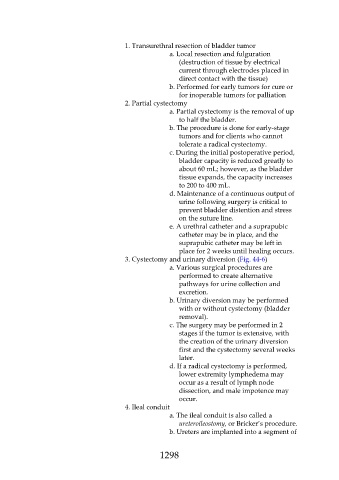Page 1298 - Saunders Comprehensive Review For NCLEX-RN
P. 1298
1. Transurethral resection of bladder tumor
a. Local resection and fulguration
(destruction of tissue by electrical
current through electrodes placed in
direct contact with the tissue)
b. Performed for early tumors for cure or
for inoperable tumors for palliation
2. Partial cystectomy
a. Partial cystectomy is the removal of up
to half the bladder.
b. The procedure is done for early-stage
tumors and for clients who cannot
tolerate a radical cystectomy.
c. During the initial postoperative period,
bladder capacity is reduced greatly to
about 60 mL; however, as the bladder
tissue expands, the capacity increases
to 200 to 400 mL.
d. Maintenance of a continuous output of
urine following surgery is critical to
prevent bladder distention and stress
on the suture line.
e. A urethral catheter and a suprapubic
catheter may be in place, and the
suprapubic catheter may be left in
place for 2 weeks until healing occurs.
3. Cystectomy and urinary diversion (Fig. 44-6)
a. Various surgical procedures are
performed to create alternative
pathways for urine collection and
excretion.
b. Urinary diversion may be performed
with or without cystectomy (bladder
removal).
c. The surgery may be performed in 2
stages if the tumor is extensive, with
the creation of the urinary diversion
first and the cystectomy several weeks
later.
d. If a radical cystectomy is performed,
lower extremity lymphedema may
occur as a result of lymph node
dissection, and male impotence may
occur.
4. Ileal conduit
a. The ileal conduit is also called a
ureteroileostomy, or Bricker’s procedure.
b. Ureters are implanted into a segment of
1298

